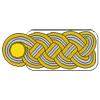It was green, as called for in the specification. The likeliest shade, as far as I can tell, is the old Humbrol 90, beige green, which is matched by the colour in the Science Museum's S6B (not the Southampton example, which had been "got at.") Recently, unfortunately, not knowing what 90 was for, Humbrol guessed that it was supposed to be Sky, and changed the formula accordingly. If you have an old tin of 90, you're fine, otherwise you'll need to mix. Incidentally, the seat would have been metal, so also green, or, maybe, unpainted.
Edgar















